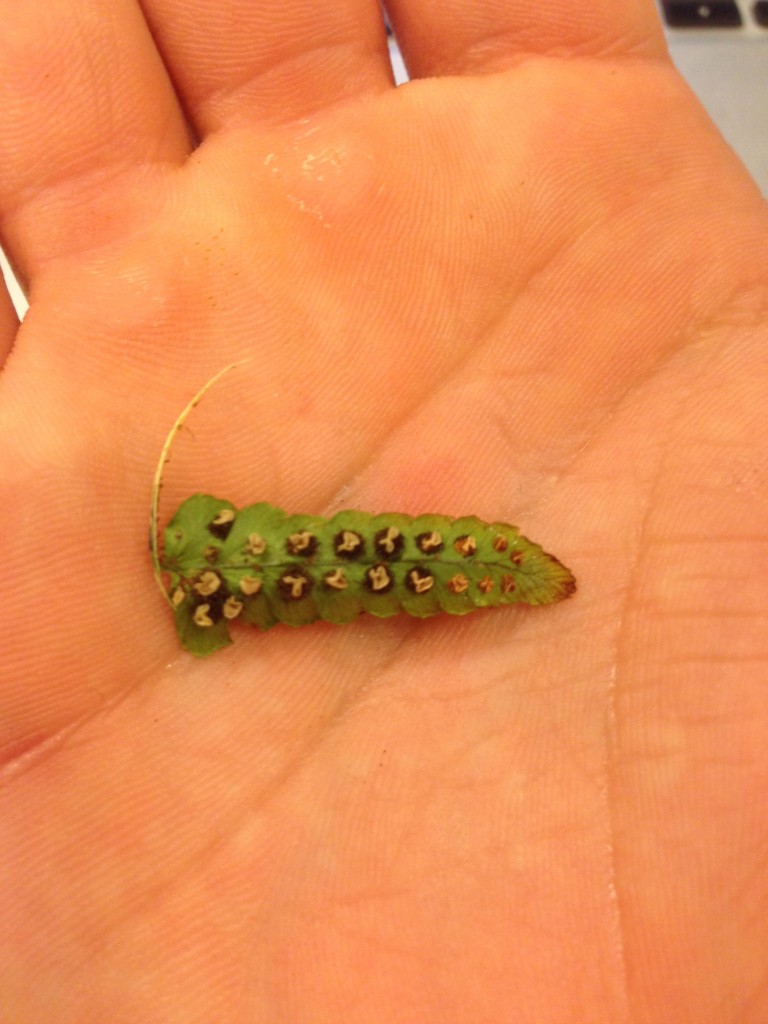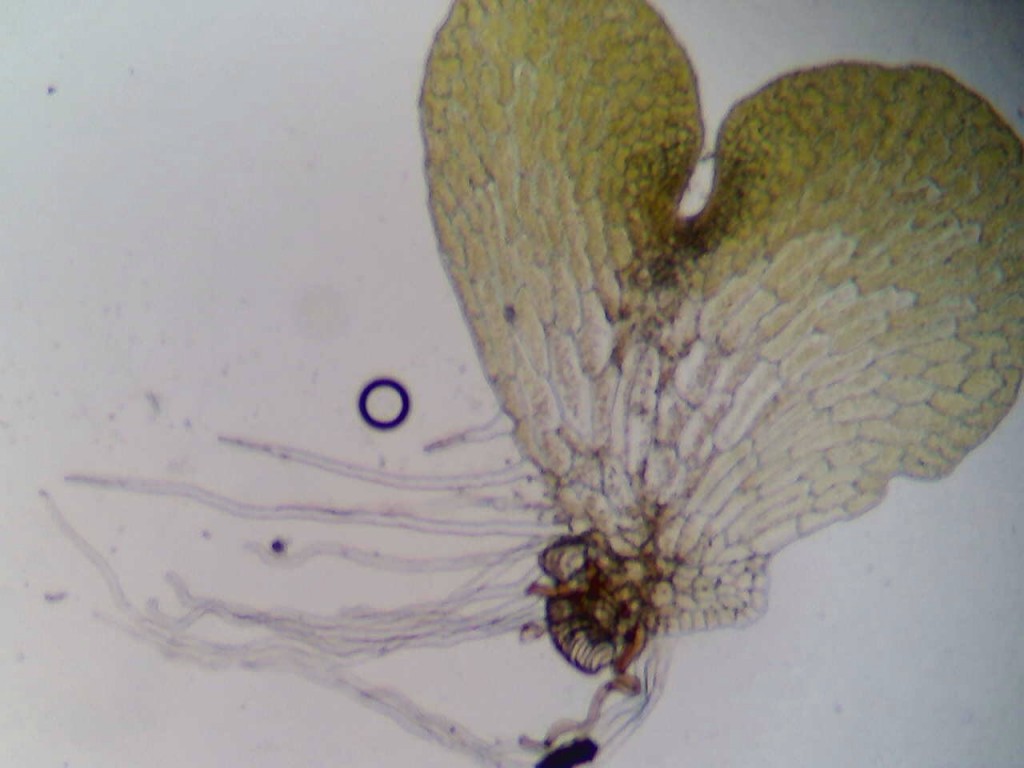With over a quarter of a million plant species estimated to be living today, 13,000 may seem like a drop in the bucket, but ferns actually show a major evolutionary step for plants as we know them today (Pearson Education, 2015). Ferns contain a variety of different types of plants under the supergroup archaeoplastida. Although ferns do not have an official classification; they are a part of the subkingdom embryophyta, which contains all land plants.
There are two different classifications of ferns: the monilophytes and the pteridophytes. Monilophytes include true ferns like the leptosporangiates, the largest group of ferns including over nine thousand species worldwide, while the term pteridophytes include both ferns and some other vascular plants. The term “pteridophyte” has fallen out of favor since it is not one monophyletic grouping like the monilophytes (Schuettpelz, 2004).
The main organism that we see, the growing and the adult fern, known as a sporophyte, is diploid. Diploidy in organisms means that they have two sets of chromosomes. Many organisms that we see today like cats, dogs, and people are also diploid organisms.
The History of Ferns

Phylogeny of ferns. The above figure shows the phylogeny of ferns with divergence dates. A phylogeny is like a family tree and shows how different organisms are related (Pryer et al., 2004).
The first fossils with fern characteristics, embryophytes, begin to appear on record during the middle of the Devonian period about 300 million years ago (USDA, 2006). The Devonian period lasted from 416 million years ago (mya) to 360 mya, and is characterized by the radiation and diversification of plant species and ended with a large scale extinction event that scientists believe was due to global cooling and rising sea levels.
These early ferns split off from the green algae around 960 mya. These are some of the earliest land plants known. The “great fern radiation” is when many modern families of ferns first began to appear. This radiation occurred in the late-Cretaceous period (Bhattacharya, 2009). Today, roughly 13,000 different species make up the class Polypodiopsida (The Plant List, 2010).
During the Carboniferous period, giant ferns dominated the landscape that grew 9 to 12 meters in height. This was before the time of the angiosperms, flowering plants that produced fruits and seeds, so there was little competition for land. There are still some giant ferns that exist today like Angiopteris evecta, or the giant fern, that can grow up to 7 meters tall and is native to Indonesia, New Guinea, coastal northern Australia and the south and west Pacific Islands (Christenhusz , 2011).
What Makes a Fern a Fern?
Ferns are classified by their vascular tissue, spore production, and lack of flowers and seeds. These plants have three major parts: the rhizome, the frond, and the sporangia. Generally, one or more fronds are attached to the rhizomes by a stipe. The rhizomes are a specialized root structure that draws up nutrients from the soil. The frond is the leaf structure of the fern while the stipe is the technical term for the stalk of the fern. The sporangia are the structures that hold the spores necessary for reproduction (University of Waikato, 2010).
Vascular plants can be differentiated from non-vascular plants by the presence of xylem and phloem. The xylem and phloem work like arteries and veins and help transport nutrients throughout the body of the plant. As the first vascular plants, ferns were able to grow taller rather than wider. Non-vascular plants, like mosses, needed to grow close to the ground in moist areas in order to gain all the nutrients needed to support the organism.
Fern Life Cycle. The video link above shows the life cycle of a fern.
Like mosses, ferns reproduce via spores instead of by seeds. These spores are dispersed via wind and water. When the spores land in a suitable habitat they will begin to grow. The spores of the plant are very small and must be viewed under a microscope because they are about 1/10th of a millimeter in size, and because of their almost invisible nature, ferns and other spore producing plants are known as cryptogams. The term cryptogam refers to their hidden reproduction, and literally means “hidden marriage” (Sytsma, 2014).
These spores, as mentioned before, are housed in the sporangium. In many species of ferns, the sporangium is found on the underside of the leaves, or fronds, of the adult fern. These tend to be grouped into sori (singular, sorus) which are visible to the naked eye as little brown spots. In many species of ferns these sori are protected by an indusium which is a thin membrane that protects the underdeveloped spores and sori. When the spores are ready to be dispersed the indusium shrivels away.

Indusium on spores of a fern. In the image above, the tan parts on top of the darker sporangium, are already starting to shrivel up. This structure is called indusium. Scale: ~ 3 cm.

Spores from the underside of a fern. Not all ferns have indusium. Individual frond: ~ 12 cm.
The spores are produced in the sporangium via meiosis. Meiosis is a form of cell division that reduces the number of parental chromosomes in half forming four daughter cells. This is the same process that produces eggs and sperm in animal species. The four daughter cells are haploid which means they contain only one set of chromosomes. These haploid spores are then dispersed by wind or water and will germinate if they land in a suitable environment. The spores then grow into a gametophyte which is also a haploid organism.
The gametophyte is a thin, photosynthetic structure that is only one cell layer thick. The gametophyte produces the sex cells: the egg and the sperm. It also contains two different types of sex organs to produce both of the sex cells. The organs are known as the antheridium, which produces sperm, and the archegonium, which produces eggs. The archegonium is a funnel shaped grouping of 4 cells which allows the sperm cell to swim down into it to meet the egg. The sperm have to swim to the eggs, so the gametophytes need to be in a very moist environment (The Plant List, 2010).

Female gametophyte. The female gametophyte contains archegonium near the crevice at the top of the gametophyte. Scale: ~1 mm. x 1 mm.

Detail of archegonium. The archegonium house the female gamete, the eggs. This is what the male gamete, the sperm, travel into for fertilization. Shown at 40x magnification.

Male gametophyte. The preserved, male gametophyte has antheridium, shown as the brown spots. These antheridium once contained sperm. Shown at 10x magnification.
Since this is only one small part of the life cycle, the gametophyte does not have a root system, but instead has rhizoids. These rhizoids are like miniature roots that serve to anchor the gametophyte and gain nutrients. Once the haploid egg and sperm meet they begin to grow into the diploid organism that we are more familiar with.
Movement of antheridia. The video link above shows the movement of the antheridia through a solution. The antheridia are the tumbling sphere shaped organisms moving rapidly across the screen.
A lot of fern characteristics are shared among other land plants. Mosses also reproduce with the use of spores, and different flowering plants have vascular tissue. In total, it is the combination of everything listed that truly makes a fern a fern.
References
Bhattacharya, D., Yoon, H. S., Hedges, S. B., and Hackett, J. D. (2009). “Eukaryotes.” The Time Tree of Life. 116-120. Retrieved from http://timetree.org/pdf/Bhattacharya2009Chap08.pdf
Christenhusz , M. (2011). Angiopteris evecta (giant fern or king fern). Retreived February 29, 2015 from http://www.nhm.ac.uk/nature-online/species-of-the-day/biodiversity/loss-of-habitat/angiopteris-evecta/
Eberle, J. R., and Banks J. A. (1996). “Genetic Interactions Among Sex-Determining Genes in the Fern Ceratopteris Richardii.” Genetics, 142, 973-85. Retrieved from http://www.genetics.org/content/142/3/973.full.pdf
Pearson Education. (2015, January). Estimated Number of Animal and Plant Species on Earth. Retrieved March 3, 2015. Retrieved from http://www.factmonster.com/ipka/A0934288.html
Pryer, K., Schuettpelz, E., Wolf, P., Schneider, H., Smith, A., & Cranfill, R. (2004). Phylogeny and evolution of ferns (monilophytes) with a focus on the early leptosporangiate divergences. American Journal of Botany, 9(10), 1582-1598.
The Plant List. (2010). “Pteridophytes (Ferns and Fern Allies).” The Plant List — A Working List for All Plant Species, 1. Retrieved on 12 Feb. 2015 fromhttp://www.theplantlist.org/browse/P/
United States Department of Agriculture. (2006, March 5). Fern Questions and Answers. Retrieved March. 5, 2015 from http://www.usna.usda.gov/Gardens/faqs/fernsfaq2.html
Sytsma, K. (2014, April 14). Vascular Cryptogams. Retrieved March 2, 2015 from http://www.botany.wisc.edu/courses/botany_401/lecture/02bLecture.html
University of Waikato. (2010 September 24) “Fern Life Cycle.” Science Learning Hub RSS. Retrieved from http://sciencelearn.org.nz/Contexts/Ferns/Sci-Media/Animations-and-Interactives/Fern-life-cycle